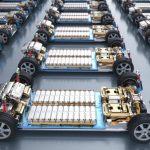Putting renewable energy within reach: Vietnam’s high-stakes pivot
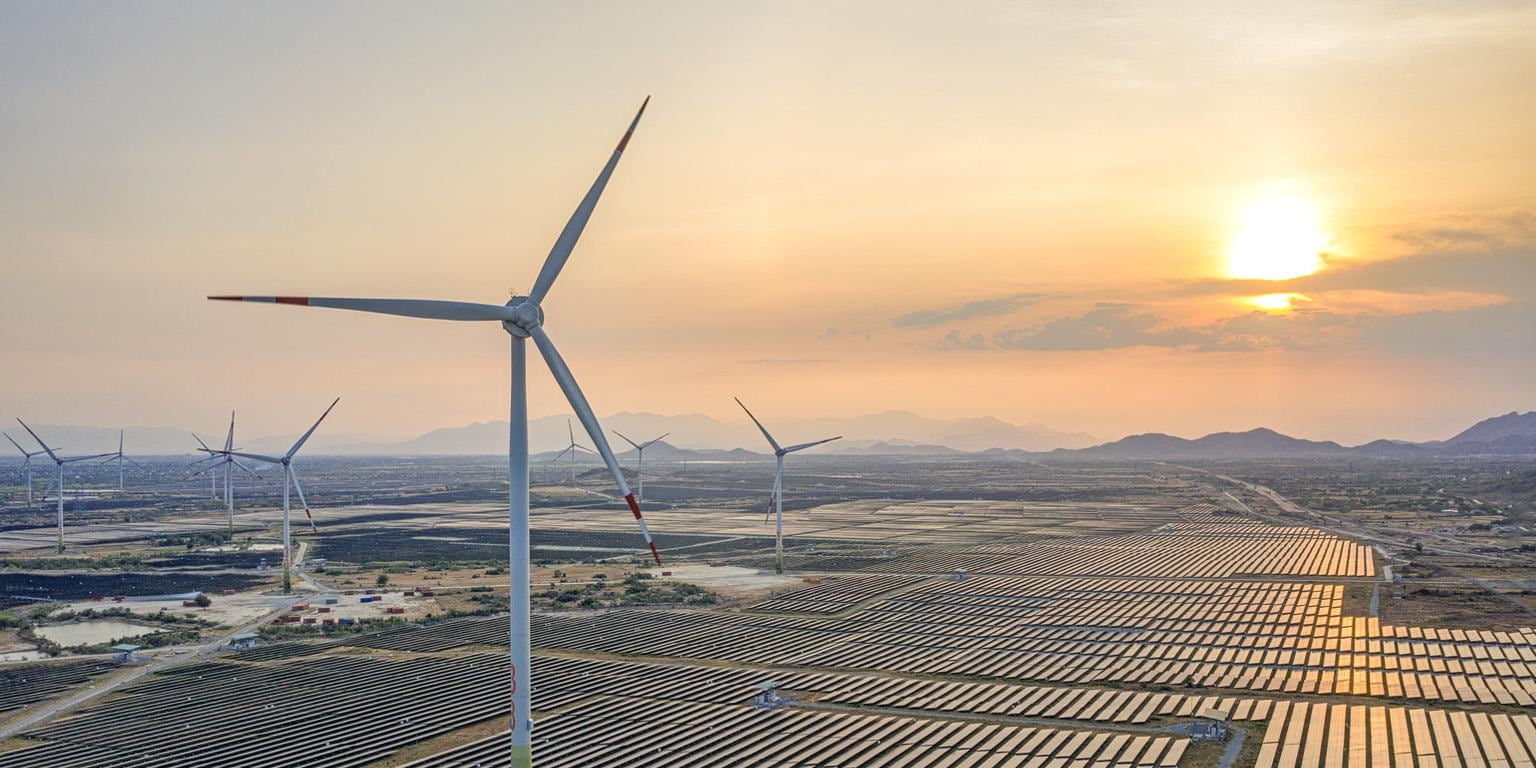
With conducive conditions, Vietnam’s renewable-energy development could increase exponentially to attract manufacturers and ensure its energy security.
Vietnam’s long-awaited Power Development Plan VIII (PDP8) has recently been approved, setting ambitious renewable-energy goals for 2030—similar to the recommendations for Vietnam to embrace renewables set out in our 2019 article, “Exploring an alternative pathway for Vietnam’s energy future.” These goals are focused on boosting renewable energy while reducing the country’s reliance on coal. This presents Vietnam with a conundrum: its renewable-energy projects are not consistently bankable at present, held back by regulations and the market.
However, current market conditions present the country’s energy sector with a unique opportunity. Many manufacturers are avoiding investing solely in China by diversifying into neighboring countries to mitigate geopolitical risk, including into Vietnam.1 To support this trend of incoming foreign direct investment (FDI), Vietnam could deploy more renewables to meet commercial and industrial (C&I) customers’ increasing demand for renewables.2 If it can seize this opportunity and successfully address the challenges that arise, Vietnam has the potential to become a regional champion for both installed renewable capacity and sustainable manufacturing.
In part through the PDP8’s boost for renewable energy, Vietnam has committed to net zero by 2050 and, to achieve this, should rapidly increase its renewable-energy mix to decarbonize the power sector by around 78 percent.3 Fortunately, Vietnam has huge renewable-energy potential, as it is the most naturally suited country in Southeast Asia to develop wind and solar energy, with the technical potential of 1,000 gigawatts (GW) (Exhibit 1). This immense opportunity for renewables capacity was explored in the 2019 article previously mentioned.
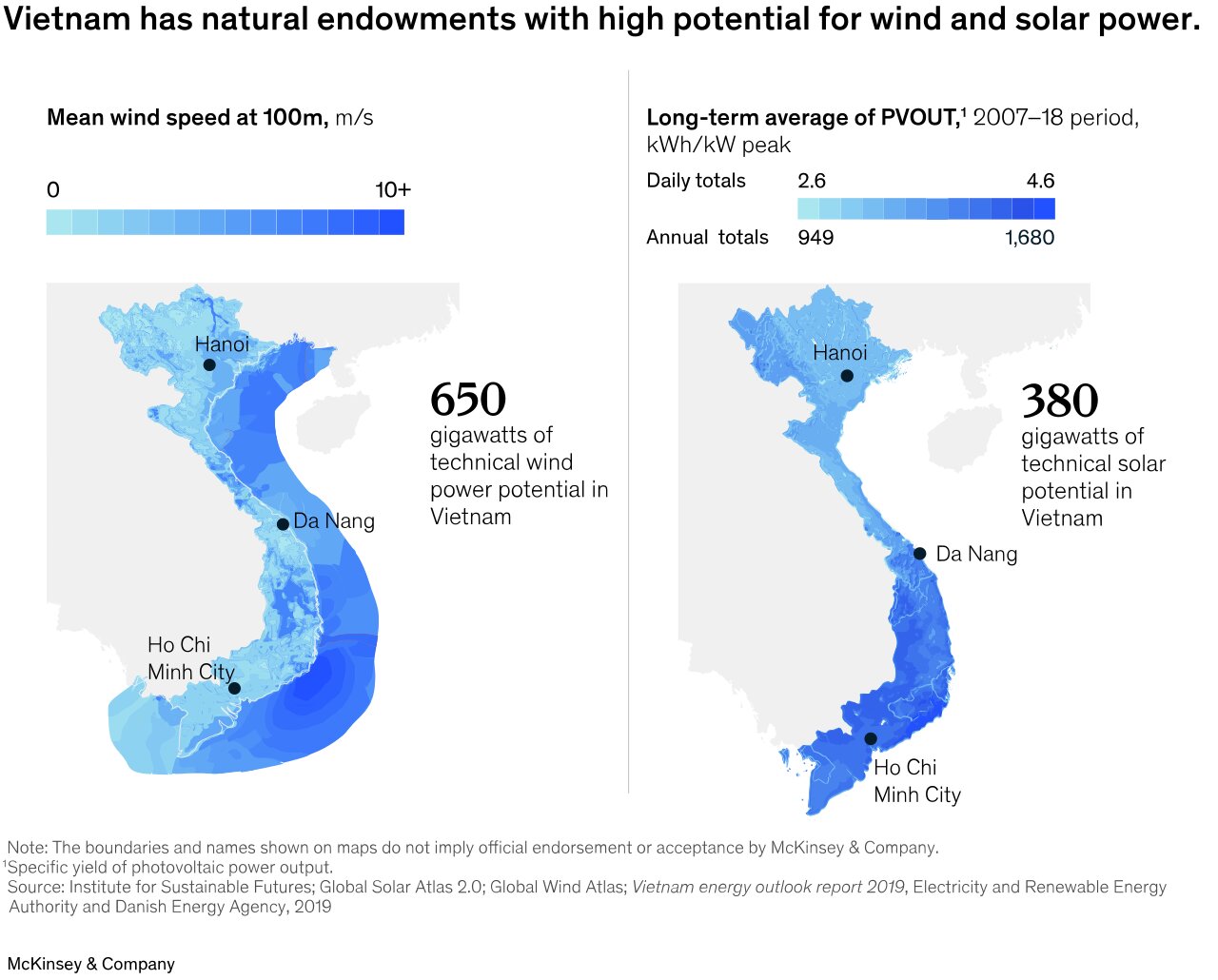
Yet, after an initial wave of (mostly solar) projects driven by favorable feed-in tariffs (FiTs), current renewable-energy projects are no longer consistently economically viable. Unless this situation changes, Vietnam’s net-zero ambitions—as well as the PDP8’s goals—are at risk, with market and regulatory constraints preventing this potential from being realized (Exhibit 2). Consider also that Vietnam’s neighbors might develop renewable energy faster, attracting international 100 percent renewable-energy (RE100) manufacturers at Vietnam’s expense. The time to ramp up renewable-energy production is now—for the business opportunity as well as the country’s sustainability.
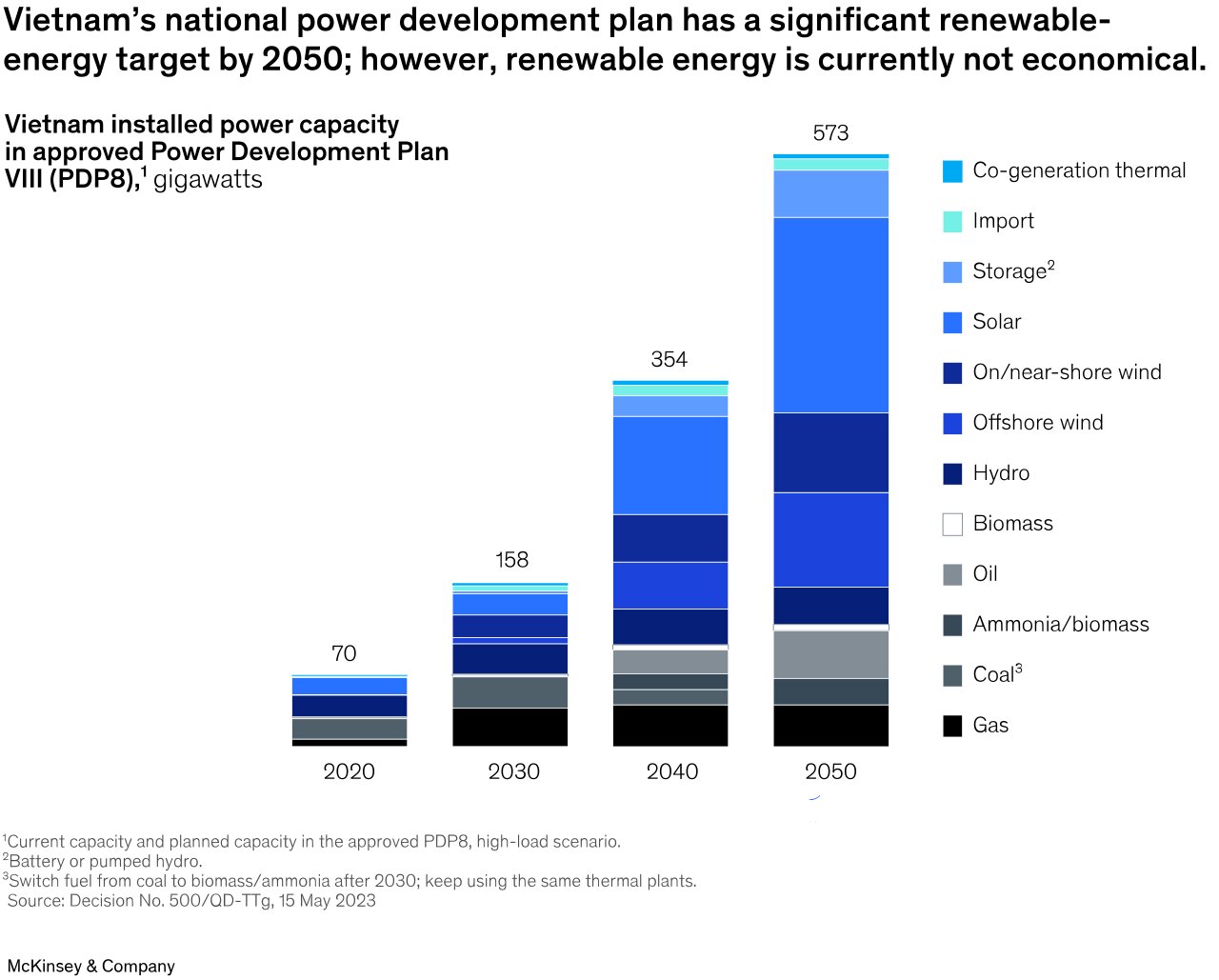
How can Vietnam achieve this? It needs to invest in, build, and integrate more solar and wind power to allow the country to provide 50 or 100 percent renewable energy (RE50/RE100) in an economically viable way—thus making it more attractive to manufacturers, investors, and renewable-energy developers. In this article, we focus on feasible steps that energy stakeholders could take to achieve this goal and highlight how collaboration between the public and private sectors could help accelerate renewable-energy development (see sidebar, “Our methodology”).
Vietnam’s pivot to renewables: Embracing the path to leadership in sustainability
If Vietnam cannot transition to renewables soon, it will likely face significant risks to its energy security, growth and development, and current economic base, as well as physical hazards from climate change—this could come at Vietnam’s expense while its neighbors prosper. The risks, as described below, raise the stakes for the urgent deployment of renewables at scale.
Energy insecurity and persistent blackouts
With electricity demand increasing and extreme weather conditions affecting the country, renewable energy offers an independent source of energy security, not dependent on fossil-fuel imports. Recently, the country has faced electricity shortages and planned blackouts because of extreme heat, droughts, and hydropower plants reaching dangerously low water levels, for example, in industrial parks in northern provinces where large global manufacturers such as Samsung and Foxconn have facilities.4 As a result, the government has instituted rolling blackouts (sometimes unannounced) across the country—particularly in the north—that have affected citizens, tourism, and industrial parks.5 This is happening while the country’s abundant natural endowments of wind and sunlight remain underutilized.
Vietnam needs to unlock its renewable-energy development as quickly as possible to reach the government’s commitment to net zero by 2050 and the bold PDP8 goals, which aim for wind, solar, and other renewable sources (excluding hydropower) to cover at least 32 percent of the country’s energy needs by 2030.6
Sources of growth and development abandoning Vietnam
Many international companies are choosing Vietnam as they diversify from China, attracted by the country’s rapid economic growth and human capital abundance.7 However, Vietnam is at risk of losing these actors’ interest if it cannot meet their increased renewable-energy demands. Many of the world’s largest manufacturers have committed to 100 percent renewable energy for their operations (for example, those in the RE100 global initiative)8; these companies may not choose Vietnam if sufficient renewable power is not available. In addition, there are many global companies that don’t yet have existing operations in Vietnam—were it able to provide RE100, the country could potentially attract more investments.
Risking Vietnam’s existing economic base
If Vietnam does not implement renewables at scale now, it could jeopardize its current economic base, as manufacturers’ products face carbon tariffs without clean energy.9 For example, more than $10 billion of Vietnam’s export turnover from industries under carbon border tax schemes might be impacted by 2030. If other countries implement similar taxes, around an additional $20 billion in exports from those industries could be impacted. And if other manufacturing products under the same regulations are included, this could further put at least $200 billion in exports at risk.10
Physical hazards from climate change
Vietnam faces significant physical risk from climate change. Urban areas especially are exposed—for example, the flood depth in Ho Chi Minh City could increase tenfold by 2050, and a 180 centimeter sea-level rise could put 66 percent of the city underwater. These climate change risks could cause 40 percent of the city to flood, and damage and associated losses could cost between $15 billion and $20 billion.11
If Vietnam doesn’t, its neighbors will
Vietnam’s lagging renewable-energy projects stand in stark contrast to its neighbors that have already started to make renewable energy economical. For instance, India has targeted 500 GW renewable energy capacity by 2030 and introduced the Electricity Act in 2003 that paved the way for open access and corporate power purchase agreements (PPAs).12 Samsung is making India a smartphone manufacturing hub, and Foxconn is in discussion to launch a plant in Tamil Nadu.13
As another example, Malaysia has already launched virtual power purchase agreements (VPPAs) that have freed up consumers with more than 1 megawatt (MW) demand and has set targets for 70 percent renewables by 2050.14 In contrast, at current tariffs in Vietnam, renewable-energy projects are often not consistently economical, and thus are viewed as unfavorable for developers.15 The country has not yet allowed direct power purchase agreements (DPPAs) nor instituted mechanisms (including auction mechanisms) that would pave the way for renewable-energy projects. Vietnam’s higher energy price and low renewable-energy penetration could lead to a financial burden for consumers and a potential loss of foreign investment.
Then how can Vietnam make this transition toward renewable energy economical while unlocking growth? To find possible solutions for this dilemma, we undertook research to show how it could be possible.
Showcasing the viability of economic renewables in Vietnam
To illustrate the feasibility of Vietnam’s renewable-energy development, we chose two example provinces—Ba Ria-Vung Tau and Binh Dinh—that have the necessary criteria for workable renewable-energy generation. Ba Ria-Vung Tau offers great industrial demand and natural resource potential, making it ideal for RE100 at an industrial park, while Binh Dinh has high natural resource potential but less industrial demand, making it a suitable province to achieve RE50 penetration.
Grid parity RE100 for manufacturers: Ba Ria-Vung Tau example
We found that if DPPAs are allowed, projects at a Ba Ria-Vung Tau industrial park could be optimized, which in turn could reduce the levelized cost of energy (LCOE) to between $65 per megawatt-hour (MWh) to $80 per MWh (Exhibit 3).
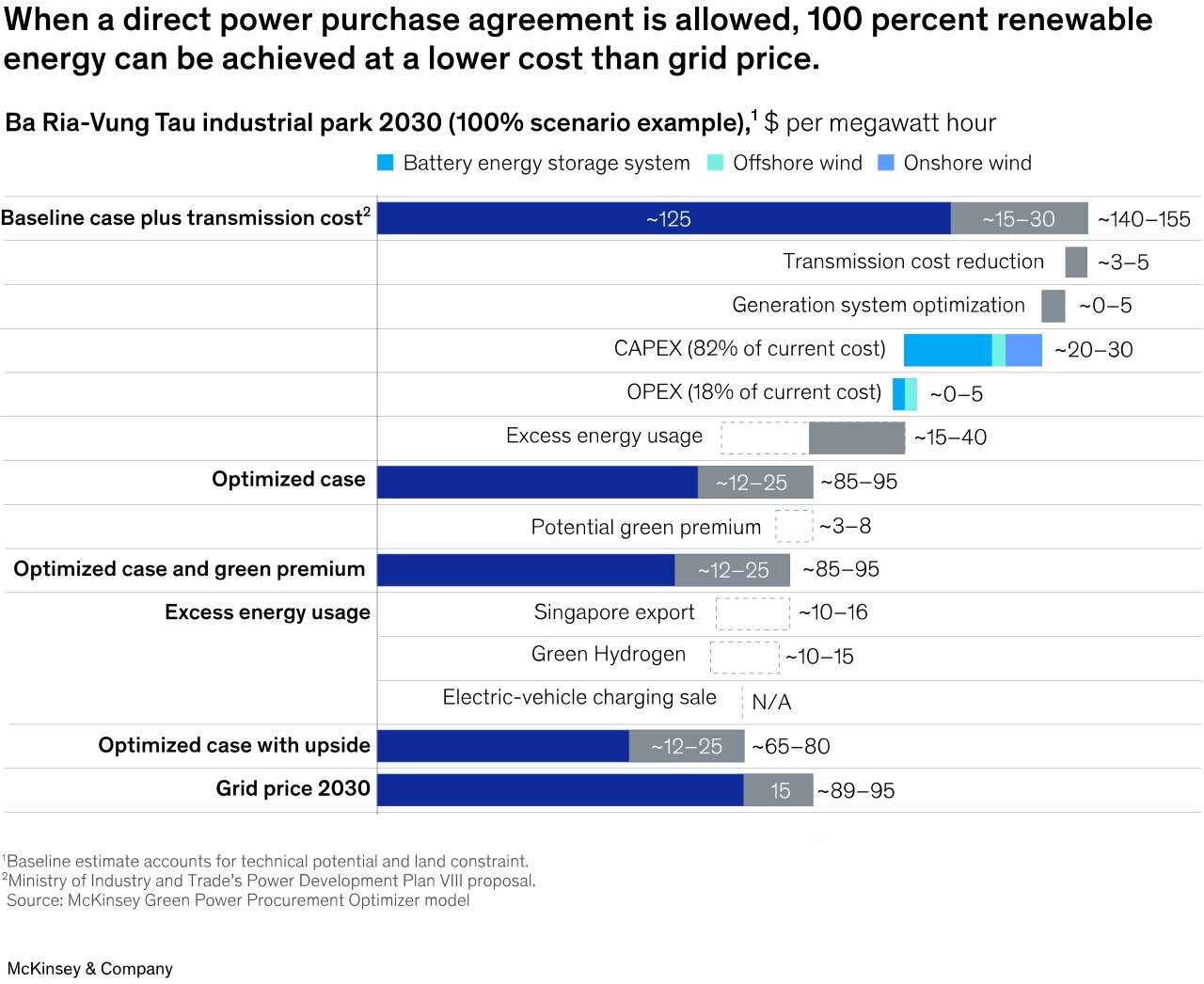
This could be achieved by taking the following steps:
Quick wins by deploying transitional capacity. Vietnam currently has several transitional projects underway, driven by the uncertainty surrounding DPPAs and the low selling price of electricity to Vietnam Electricity (EVN) compared to previous FiT prices.16 Negotiations have the potential to achieve savings of 10 to 20 percent on capital expenditure compared to constructing new solar and onshore wind facilities. For instance, in the surrounding provinces of Ba Ria-Vung Tau, Chau Duc Industrial Park, and Xuyen Moc, onshore wind is currently stranded. Bringing these online would add a low cost of about 150 MW of renewable capacity to the power mix, a significant quick win.17
Selling directly. DPPAs are an essential mechanism for the shift to renewable energy. DPPAs allow companies generating renewable energy to sell this energy directly to private companies or consumers, enabling these entities to access renewable energy quickly without waiting for the infrastructure of publicly available sources to improve. DPPAs also provide renewable-energy companies with the ability to scale their operations, making them more financially viable. In addition, DPPAs increase the likely bankability of projects by guaranteeing offtake, which reduces a project’s cost of capital and thus final LCOE.
Without DPPAs, offshore wind and utility-scale solar can’t be used to provide renewable energy within an industrial park: DPPAs are required to access renewable sources outside an industrial park, and for the park to achieve RE100, renewable-energy generators need to be able to sell clean electricity directly to private offtakers.
Going big. Developers and investors need to think big and commit to developing multi-GW pipelines. We estimate that this action could reduce project risks, as well as lower capital expenditure by 5 to 15 percent and operating expenses by 10 to 20 percent. Developers could incentivize suppliers to invest locally in long-term, large-scale projects, creating win–win supplier partnerships. These could be boosted in three ways: first, by establishing a cost-efficient local-manufacturing ecosystem to support this multi-GW pipeline, enabled by volume discounts and the localization of components; second, by collaborating to develop local talent for the long term through partnerships with the National Innovation Centre, the Ba Ria-Vung Tau government, and foreign governments like Denmark18; and third, by investing in self-performing operation and maintenance (O&M) capabilities, shifting from external O&M contractors to in-house ones.
Embracing cutting-edge downstream green technology. According to our analysis, the cost of energy could be further cut by using the excess electricity produced during the sunniest and windiest times of day. For example, this surplus generation could be sold to the grid or used to produce green hydrogen and charge electric vehicles, all of which could be valuable depending on different market conditions.
Capitalizing on green premium. We have observed that C&I customers, particularly RE100 companies, are potentially prepared to pay up to 10 percent green premiums for renewable energy in Vietnam, which would lead to a lower electricity cost for developers. If Vietnam cannot provide RE100, these customers will likely be happy to move to alternative markets for production.
Grid Parity RE50 for a province: Binh Dinh example
We believe that grid parity for RE50 is possible for the entire Binh Dinh province. This could be achieved through a number of levers, which would slash LCOE from the normal $100 per MWh (approximate) to an optimized $85 per MWh or thereabouts (Exhibit 4). A number of actions could be taken to reach these goals.
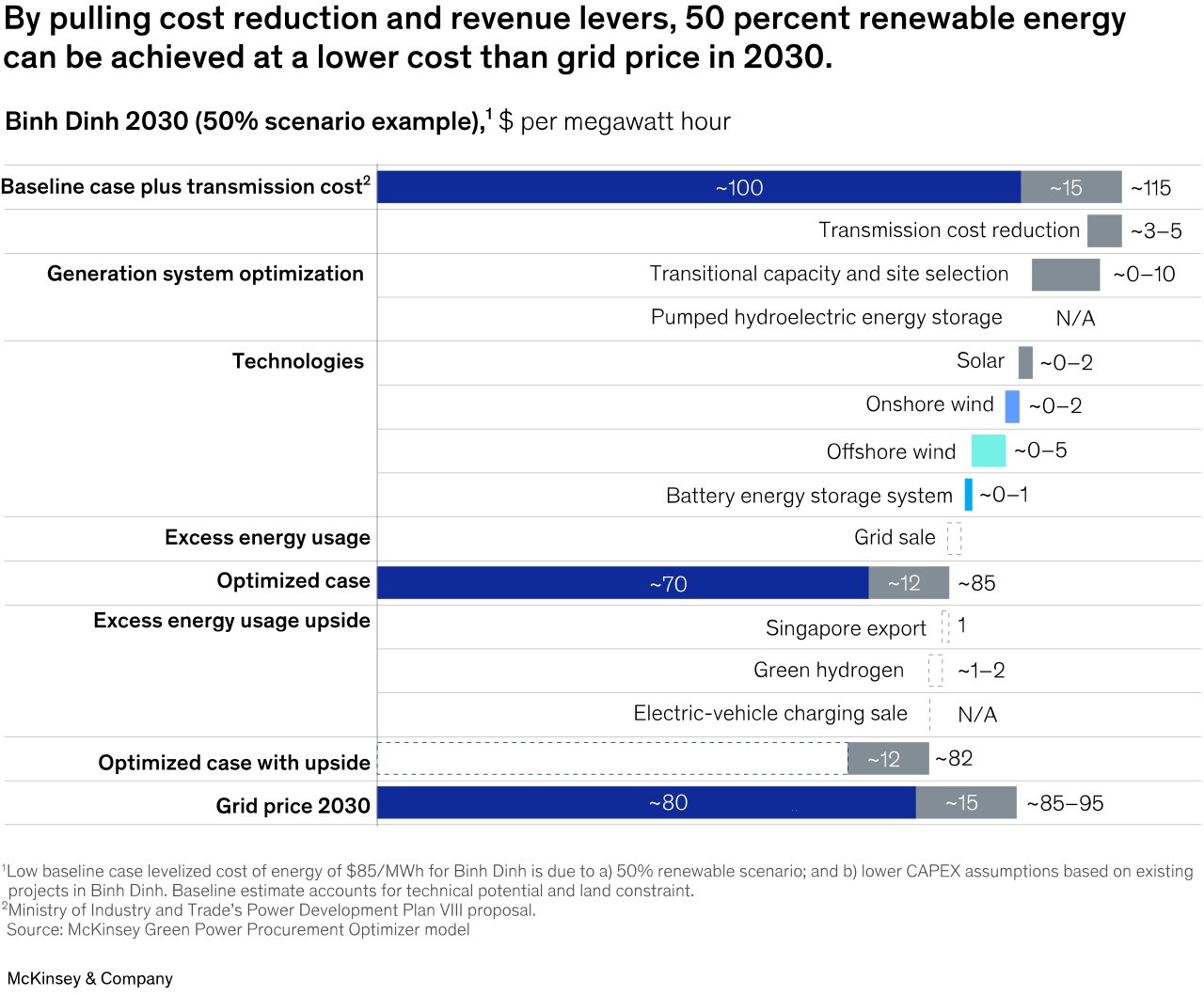
Stopping the waste: Investing in energy upgrades
Grid congestion is a major problem in renewable-energy centers, including Binh Dinh. Some 110 kilovolt (kV) lines (such as Vinh Son-Hoai Nhon and Vinh Son-An Khe) are either degraded or congested (or both) after operating for about 30 years and are not designed to accommodate a renewable-energy mix.
Additional grid investment would be required in Binh Dinh to increase its flexibility to provide significant renewable energy—although this could double the cost of transmission and distribution (T&D). However, we estimate that a grid upgrade could also lead to a reduction in T&D losses by about 10 percent (most of which come from transmission). In addition, total capital expenditures and operating expenditures could be reduced through a combination of cost reduction techniques, such as inventory optimization and negotiation with contractors based on past performances, leading to an additional 10 percent cost reduction.
Extra financing support would be needed for a grid upgrade investment. This could include leveraging international green funds, such as the $15.5 billion Just Energy Transition Partnership (JETP) funds.19 Private capital in construction and operations is another possible source of funding—consider, for instance, the Trungnam Group that has invested in and has been operating the $85 million 500 kV substations and transmission lines in Ninh Thuan.20
Optimizing the system: Using the best energy mix in the best location
An RE50 center is best placed in an area that has existing renewable-energy capacity with high potential for further capacity and existing solid infrastructure. Binh Dinh is well placed for solar and wind development that could supply significant renewable power and already has existing renewable-energy centers in Vinh Thanh, Tay Son, Nhon Hoi-Quy Nhon, and Phu My.
The best energy mix could be maximized in the following ways:
Minimizing and standardizing design. Suppliers could minimize design through a design-to-value (DtV) approach, while developers could standardize “blocks” of modules and processes for rapid construction and repeatability—shrinking LCOE by around $1 per MWh, according to our analysis. This could unlock scale and lower the cost of multi-GW development portfolios.
For instance, with regard to solar, changing the back sheet material of photovoltaic modules from polyvinyl fluoride or polyvinylidene fluoride to flexible flat cable could reduce costs. In general, moving to materials that are easier to access could help cut down on cost and time for renewable-energy plants.
For onshore wind, our estimations show that DtV initiatives like special connectors and removing castings could lead to a 5 to 10 percent capital expenditure reduction.
Operational excellence. Based on industry expert input, we believe that optimizing O&M could help lower LCOE by around $5 per MWh. For example, central control towers and remote operations could improve asset availability and reduce risk. Performance could be improved by real-time generation and relevant data analysis. Insights into the weather and its impact on plants, as well as fault detection, could help identify problem areas and enable proactive repairs. This data use, along with thermography-based hotspot detection, could cut down unplanned maintenance incidents by up to around 50 percent.
The ‘and?’: How Vietnam’s public and private sector can make this happen
The challenges may appear formidable, but we believe that Vietnam could solve its energy dilemma and secure its economic future through public- and private-sector collaboration. Ten crucial actions could be taken to reduce the cost of renewables, and by following a logical sequence of specific actions, a synchronized effort could realize economically viable RE100 and RE50 in the country.
Key public-sector unlocks
Six general best practices could unlock renewables:
- Enable DPPAs to allow for off-site renewable-energy trades. This could ensure renewable-energy bankability and profitability, for example, through net metering and open access. DPPAs would get rid of constraints—buyers could buy clean energy directly from private developers (that are outside consumers’ sites) rather than a mix of energy from EVN. This action could encourage developers to stay in, or enter, Vietnam.
- Commit to clear regulations and targets. Regulation is required to create fairness within the industry and transparency for developers and would need to include the following:
- revise and improve model PPAs on termination and curtailment compensation—for instance, where EVN is unable to purchase offtake energy
- create mechanisms to award new renewable-energy projects including site allocation and offtake price, particularly for offshore wind
- establish targets for the development of hydrogen and other alternative fuels, along with preferential policies for these industries
- Invest in the grid. Developers and investors could be attracted to new projects if the grid were updated to allow JETP projects and other investments. The ability of the private sector to participate in the grid development and operation may also make Vietnam more enticing to investors.
- Finalize negotiations with various Association of Southeast Asian Nation countries to export renewable energy. The public sector could define the rules for request-for-proposal applications and government-to-government memorandums of understanding with nearby countries.
- Pilot RE100 industrial parks in leading “lighthouse” provinces. Ambitious provincial leaders could take leading positions in renewables and attract FDI by encouraging the establishment of an RE100 industrial park. This would require collaboration by the provincial Ministry of Planning and Investment, Ministry of Natural Resources and Environment, and central government agencies to attract both anchor renewable-energy developers and C&I customers.
- Introduce other key enablers. When it comes to the execution phase, the government could consider putting in place other measures as soon as possible, such as a carbon tax and carbon market, thus incentivizing the adoption of renewables with their comparatively lower prices.
Bold moves from private-sector leaders
Working in tandem with the public sector, players in the private sector can act immediately to seize the opportunity for growth. They could consider four big strategic decisions:
- Developers commit to a multi-GW pipeline. This could unlock supplier investment in the local value chain ecosystem and lower costs through economies of scale. In addition, it would likely incentivize local workforce development by local authorities.
- C&I customers commit to offtake through DPPAs. C&I customers could guarantee demand and offtake, making initial RE100 projects immediately bankable—especially if they are willing to pay a green premium for 24/7 renewable electrons.
- Developers and suppliers reduce costs through standardized design. Once developers have committed to a scale pipeline, they could standardize one optimized design across different sites, allowing rapid commissioning and lower costs.
- Developers and consumers embrace downstream green technology. Developers could consider investing in (or creating) green technology to accelerate the renewable-energy journey—green hydrogen or electric-vehicle charging, for example. In addition, consumers could commit to green technology uptake, such as hydrogen offtake quantity and price.
The power of collaboration
With the public and private sectors acting in tandem, Vietnam could achieve economical RE50 or RE100 across three time horizons. First, within the next 12 to 18 months, the country could establish the regulatory framework and commit to it, launching model PPA and DPPA pilots, accompanied by a public commitment to RE50 and RE100. Second, Vietnam could significantly increase its installed renewables capacity and continue to attract FDI within the next five to seven years. This could be achieved by transitioning to RE50 or RE100 in some provinces and enabling renewable-energy surplus outlets. Third, within a decade, the country could accelerate the net-zero commitment with widespread renewables across the country. With this, Vietnam could become the leading country in Southeast Asia with the highest-value renewable-energy economy.
Vietnam’s urgent need to develop its renewable-energy generation to achieve the ambitious PDP8 goals can be met, even though the journey is beset with challenges. This could be achieved with the public sector paving the way by establishing clear regulations and reducing project risks for developers, and the private sector committing to a large-scale transition with multi-GW projects, creating a local renewable-energy ecosystem in Vietnam, and being prepared to pull cost reduction levers.
Source : mckinsey.com
